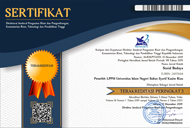Tinjauan Antropologi Hukum dan Budaya terhadap Mudik Lebaran Masyarakat Yogyakarta
Abstract
The focus of this study lies on how the Islamic concept sees the phenomenon of the Eid homecoming?, and how is the legal and cultural anthropological review of the Yogyakarta society Eid homecoming?. Seeing and understanding in depth about the concept of Islam and a review of legal and cultural anthropology used as an analysis knife of the Eid homecoming phenomenon is the purpose of writing this article. While this research is a qualitative research by looking at the cultural value orientation in the Yogyakarta society. Then, the methods used to collect data are observation, interviews, and data collection through analysis of studies of various literature that have relevance to the study to be carried out with analytical descriptive properties through analysis of the Huberman and Miles model. Therefore, the results of the study show that the Eid homecoming carried out by the Yogyakarta society is one of the social actions or activities in culture that fall into the general category, namely "al Bārā'āh al-Ashlāyyāh" and contains the value of worship in Islam. Meanwhile, the review of legal and cultural anthropology serves to explain the legal and culture that develops in the life of the Yogyakarta society.
Keywords
Full Text:
PDFReferences
An-Nawawi, I. (2015). Riyadhus Shalihin. Jakarta: Pustaka Al-Kautsar.
Bakri, S. (2011). Peta Sejarah Peradaban Islam. Yogyakarta: Fajar Media Press.
Berger, P. L., & Luckmann, T. (1990). Tafsir Sosial atas Kenyataan: Risalah tentang Sosiologi Pengetahuan, terj. Jakarta: LP3ES.
Bintarto, R. (1983). Urbanisasi dan Permasalahannya. Jakarta: Ghalia Indonesia.
Buwono, H. (2007). Merajut Kembali Keindonesiaan Kita. Yogyakarta: Gramedia Pustaka Utama.
Fuad, M. (2011). Makna Hidup Di Bauk Tradisi Mudik Lebaran (Studi Fenomenologi Atas Pengalaman Pemudik Dalam Merayakan Idul Fitri Di Kampung Halaman). KOMUNIKA: Jurnal Dakwah Dan Komunikasi, 5(1), 107–123.
Hasbullah, A. M. M. A. R., & Rodli, A. (2004). Hadis-Hadis Muttafaq ‘alaih Bagian Munakahat dan Mu’amalat. Jakarta: Prenada Media.
Iriyanto, A. M. (2012). Mudik dan keretakan budaya. Humanika, 15(9).
Ismail, F. (2017). Sejarah & kebudayaan Islam: Periode Klasik Abad VII-XIII M. Yogyakarta: IRCiSoD.
Karim, M. A., Fahsin, F., & Maya, A. (2007). Islam Nusantara. Yogyakarta: Pustaka Book Publisher.
Koentjaraningrat. (1990). Sejarah Teori Antropologi II. Jakarta: UI-Press.
Lestari, F. (2019). Kajian Karakteristik Arus Mudik Lebaran Menggunakan Survei Online. Jurnal Penelitian Transportasi Darat, 21(1), 31–36.
M. H. Amin Syakur. (2000). Islam dan kebudayaan Jawa. Yogyakarta: Gama Media.
Madjid, N. (2008). Islam Doktrin dan Peradaban, Cet (Ke-VI). Jakarta: Paramadinah.
Nottingham Elizabeth, K. (2002). Agama dan Masyarakat, Suatu Pengantar Sosiologi Agama, PT. Jakarta: Raja Grafindo Persada.
Nuzuli, A. K. N. A. K. (2020). Komunikasi Orang Tua dan Tingkat Stres Mahasiswa Perantauan Pada Larangan Mudik Covid 19. KOMUNIDA: Media Komunikasi Dan Dakwah, 10(02), 242–260.
Soebyakto, B. B. (2011). Mudik lebaran: studi kualitatif. Jurnal Ekonomi Pembangunan, 9(2), 62–67.
Soekanto, S. (2002). Sosiologi: Suatu Pengantar (Cet. ke-34). Jakarta: Raja Grafindo.
Wahid, A. (2007). Islam kosmopolitan: Nilai-Nilai Indonesia & Transformasi Kebudayaan. Jakarta: Wahid Institute.
Wahid, A. W. (2007). Universalisme Islam dan Kosmopolitanisme Peradaban Islam”, dalam Nurcholish Madjid, dkk. In Islam Universal. Yogyakarta: Pustaka Pelajar.
DOI: http://dx.doi.org/10.24014/sb.v18i1.12725
Refbacks
- There are currently no refbacks.
Published by:
Center for Research and Community Development
Universitas Islam Negeri Sultan Syarif Kasim Riau
Jl. H. R. Soebrantas KM 15,5 ,Tuah Madani, Tampan,
Pekanbaru, Riau 28293
Indexed By:


.jpg)



